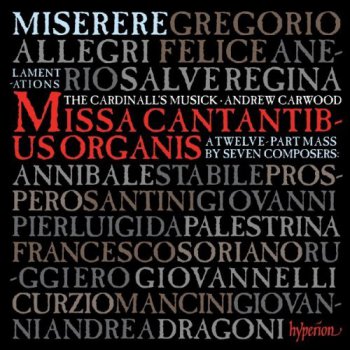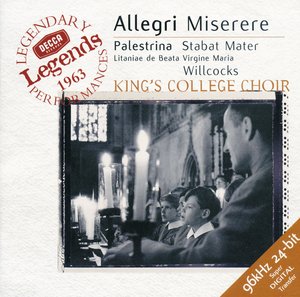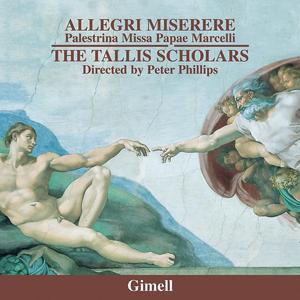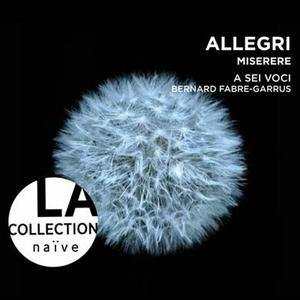Allegri's Miserere mei – a quick guide to the best recordings
Gramophone
Thursday, February 16, 2017
A quick overview of the greatest recordings of Allegri's ever-popular choral work

Miserere mei, Deus, etc
The Cardinall’s Musick / Andrew Carwood
Hyperion
Following their Gramophone Recording of the Year Award in 2010, Andrew Carwood and Hyperion have risked all to record a curiosity that was published in 1930 but has been quietly gathering dust ever since. It is a cyclic Mass in 12 voices, probably from the 1580s, based on Palestrina’s famous motet Cantantibus organis and composed by seven composers. Palestrina himself wrote part of the Gloria but the rest is by men who are so little known that they hardly even make it into Grove. That looks like commercial suicide. What this disc shows, though, is that they all deserve a much better fate than being buried in a list of Palestrina’s younger colleagues. It also shows that a burning commitment can lift music off the page and give it real life. The movements by Annibale Stabile and Ruggiero Giovannelli are perhaps the ones that struck the ear most forcibly; but this is all really exciting stuff and should be heard by anybody who cares about music of the late 16th century.
But the rather later composer Allegri gets the main billing here, presumably because that’s the only way to sell the CD. His Miserere – famous largely because of embellishments written down a century after he died – gets a lovely performance, if the three other motets added here slightly overstay their welcome. But the opening work is a treasure: Felice Anerio’s eight-voice Salve regina.

Miserere mei, etc
Roy Goodman treb King’s College Choir, Cambridge / Sir David Willcocks
Decca
It’s doubtful if any recording made by the Choir of King’s College, Cambridge, in the fertile Willcocks era, will prove more enduring than this celebrated performance of Allegri’s Miserere. Admittedly there are more authentic versions in the catalogue, authentic not only in that they use the original Latin words where Willcocks opts for an English translation, but also in the sense that they search for a style less obviously redolent of choral evensong and the Anglican tradition. At the farthest extreme from King’s, other versions strip Allegri’s score of its various 18th- and 19th-century accretions – a nice piece of musical archaeology which, ironically, reveals the utter plainness of the Miserere when denied its familiar jewels, and sounds like an impostor when dressed up in even more garish baubles. For many the richly communicative singing of King’s remains the ideal, however far removed it may be from the orginal intentions of Allegri. The Miserere is accompanied here by some classic Palestrina performances, which are still as fresh as when they were recorded in 1964. Some tape hiss intrudes, but otherwise the sound is excellent. A fabulous disc.

Miserere mei (two versions) with Palestrina Missa Papae Marcelli. Stabat mater. Tu es Petrus
Tallis Scholars / Peter Phillips
Gimell
The Tallis Scholars’ debut recording, which included the Pope Marcellus Mass and Allegri’s Miserere, appeared in 1980 and in 1994 they issued a video (also available as a CD) of a concert in the Sistine Chapel commemorating the 400th anniversary of Palestrina’s death. This third recording has far more in common with the latter interpretation than with the first, and in essentials little seems to have changed in 10 years, but the wholly ethereal approach in 1980 is changed into something more robust. That’s attributable as much to the difference in the singers’ timbres as to a change in Peter Phillips’s view of these works.
This new recording’s principal innovation is the inclusion of two different readings of the Allegri (or rather, the modern-day elaboration of it that bears his name – a distinction that Phillips’s booklet-notes don’t acknowledge): one sung quite ‘straight’, and the other with embellishments to the famous top line evolved over many years (and countless live performances) by soprano Deborah Roberts. This is the main reason for recommending the disc, even though the ornaments to the opening verses are a little slow to get off the ground. By the end, the excitement is undeniable.

Miserere mei (two versions) with Missa Vidi turbam magnam. De ore prudentis. Repleti sunt omnes. Cantate Domino
A Sei Voci / Bernard Fabre-Garrus with Dominique Ferran org
Naïve
Allegri’s setting of the psalm Miserere mei is presented in two versions. The first is sung with ornamentation added by the French musicologist Jean Lionnet following 17th-century models, while the second presents the Burney-Alfieri version familiar from the classic 1963 Willcocks recording (below). A Sei Voci produce a rather varied sound, which is at times somewhat flat and white but at its best is imbued with an appropriate Italianate edge. For the most part the embellishments are negotiated with style and verve; just occasionally they’re fuzzy or insecure. Mise-rere mei apart, hardly any of Allegri’s music is heard either liturgically or in the concert hall. By training a pupil of Nanino, a distinguished follower of Palestrina, his best music is written confidently in the High Renaissance contrapuntal manner. The six-voice Missa Vidi turbam magnam, composed on one of his own motets, is a fine work, and shows that the stile antico, far from being a mere academic exercise, could still be vividly sonorous and dramatic, qualities which are brought out in this reading. The disc is nicely rounded out with a selection of short continuo motets in the popular new manner, well established in Northern Italy, which was becoming fashionable in Rome.











